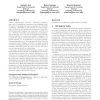Free Online Productivity Tools
i2Speak
i2Symbol
i2OCR
iTex2Img
iWeb2Print
iWeb2Shot
i2Type
iPdf2Split
iPdf2Merge
i2Bopomofo
i2Arabic
i2Style
i2Image
i2PDF
iLatex2Rtf
Sci2ools
106
click to vote
GIS
2007
ACM
2007
ACM
Evacuation route planning: scalable heuristics
Given a transportation network, a vulnerable population, and a set of destinations, evacuation route planning identifies routes to minimize the time to evacuate the vulnerable population. Evacuation route planning is a vital components of efforts by civil authorities to prepare for both natural and man-made disasters (e.g., hurricanes, terrorist acts, etc). However, evacuation route planning is computationally challenging due to the size of transportation networks, the large number of evacuees, and capacity constraints. For example, the number of evacuees often far exceeds the bottleneck capacity, i.e., the minimum cut of a given network. Current approaches (e.g., linear programming and Capacity Constrained Route Planner (CCRP), a recently proposed evacuation planning algorithm) do not scale well because of intensive computation needs in order to produce the schedules of evacuees as well as routing plans. This paper presents innovative heuristics scalable to very large transportation ...
Database | Evacuation Planning Algorithm | Evacuation Route Planning | GIS 2007 | Intelligent Load Reduction |
| Added | 09 Nov 2009 |
| Updated | 09 Nov 2009 |
| Type | Conference |
| Year | 2007 |
| Where | GIS |
| Authors | Sangho Kim, Betsy George, Shashi Shekhar |
Comments (0)

